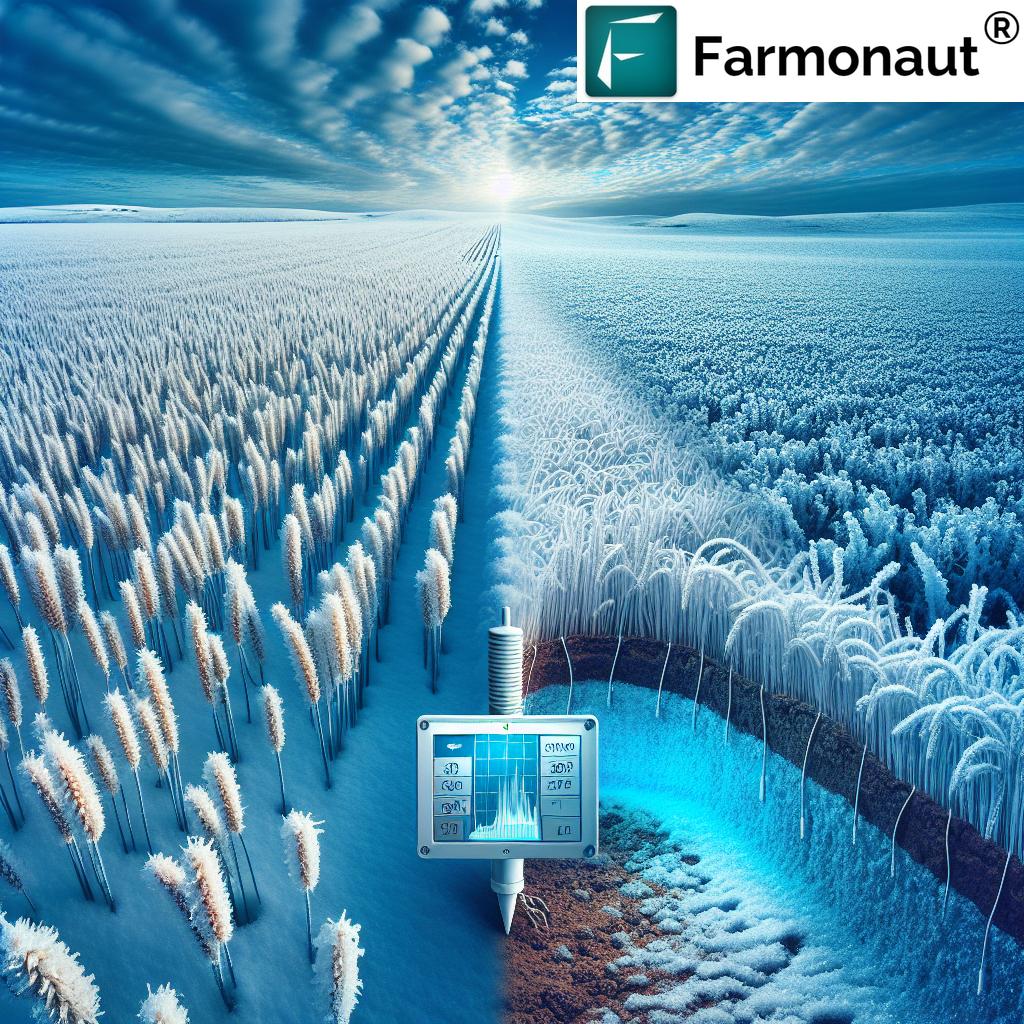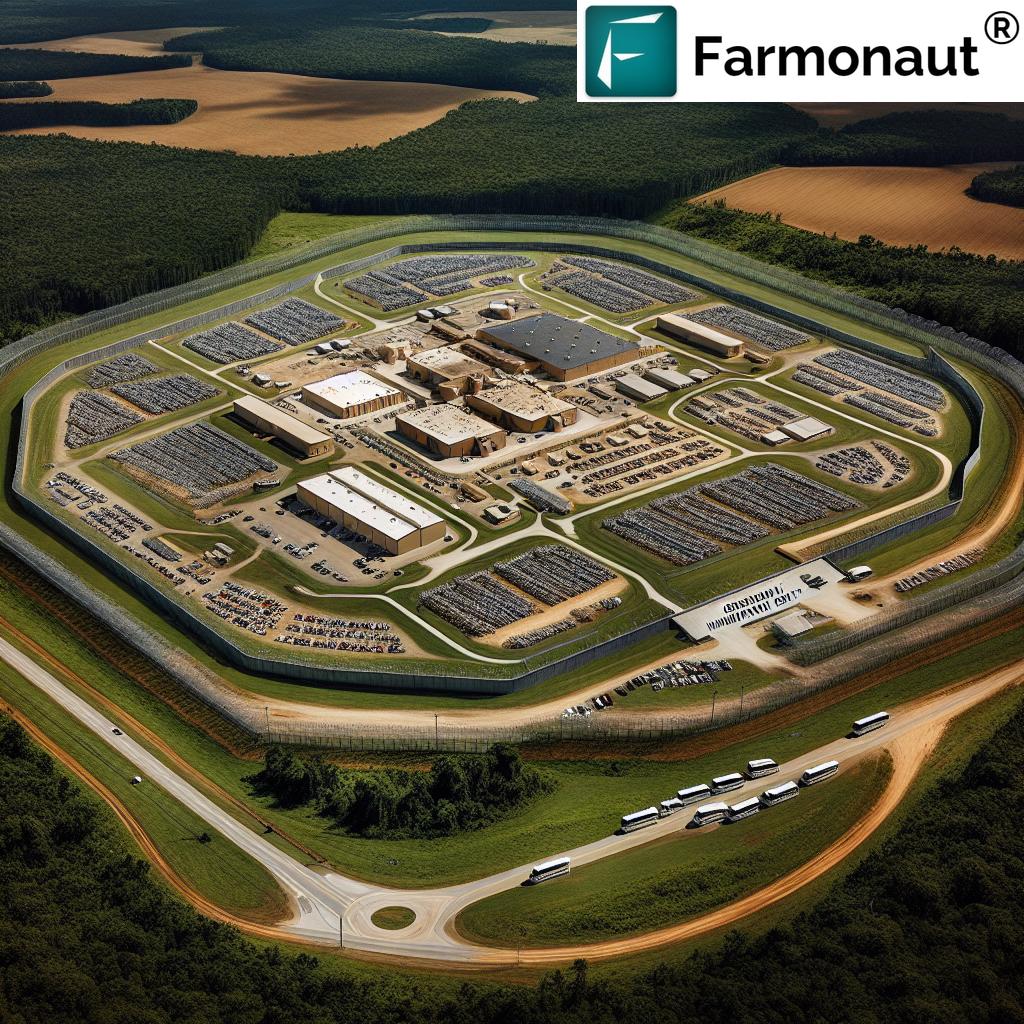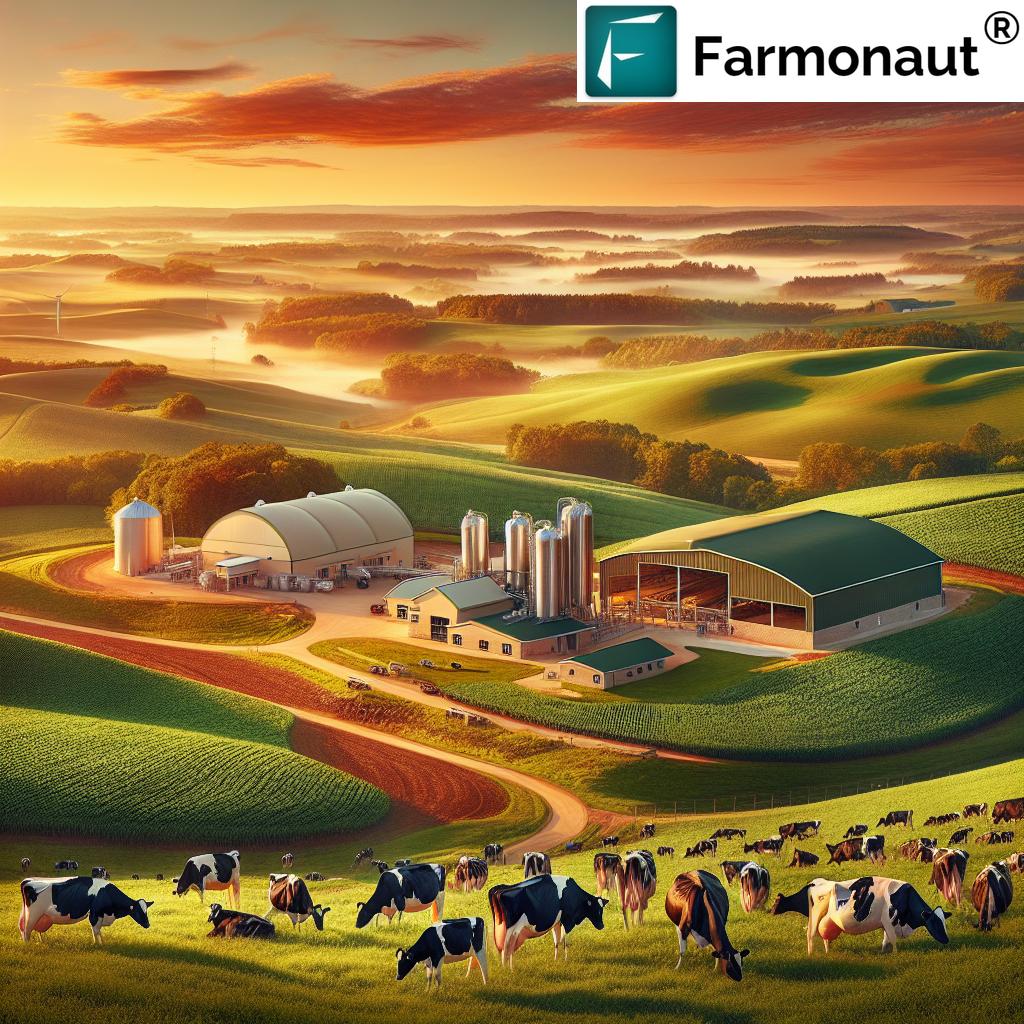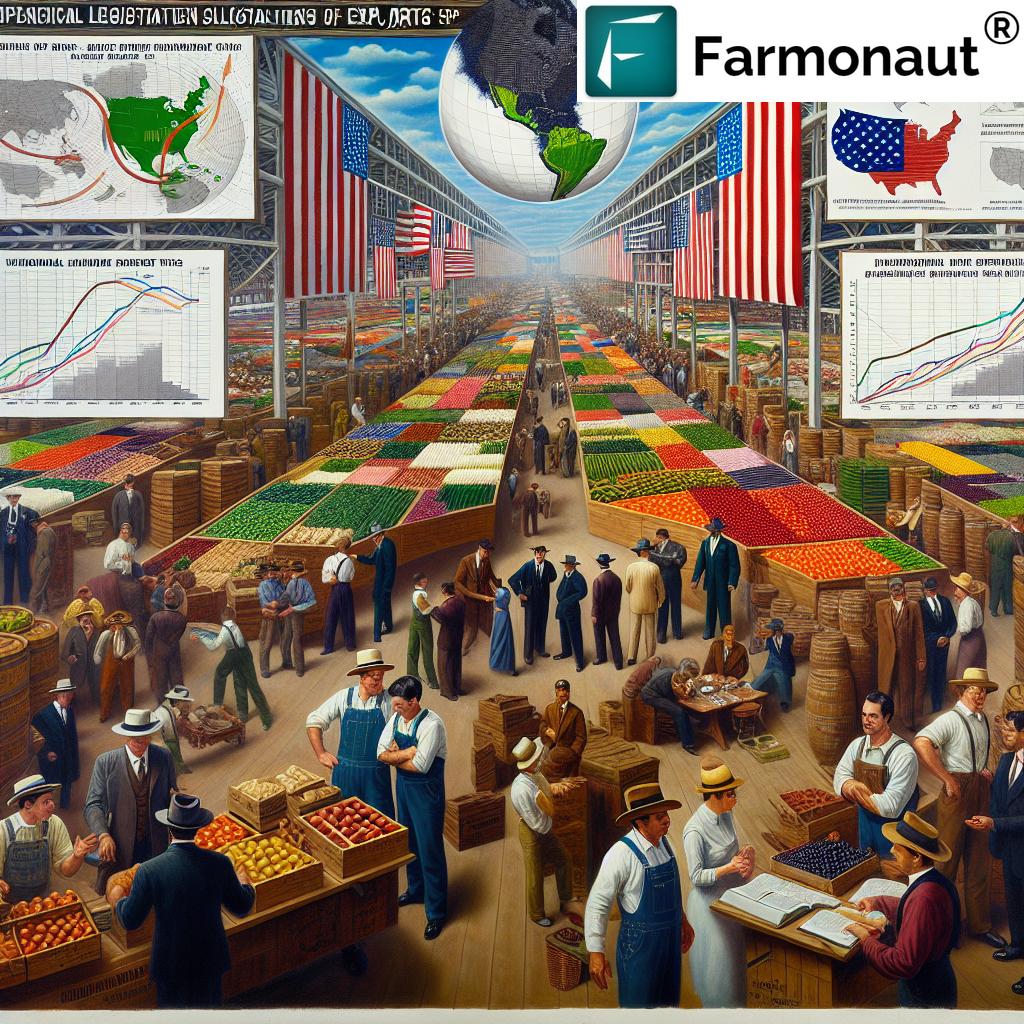Navigating Carbon Markets: A Comprehensive Guide for Illinois Farmers to Boost Profits and Sustainability
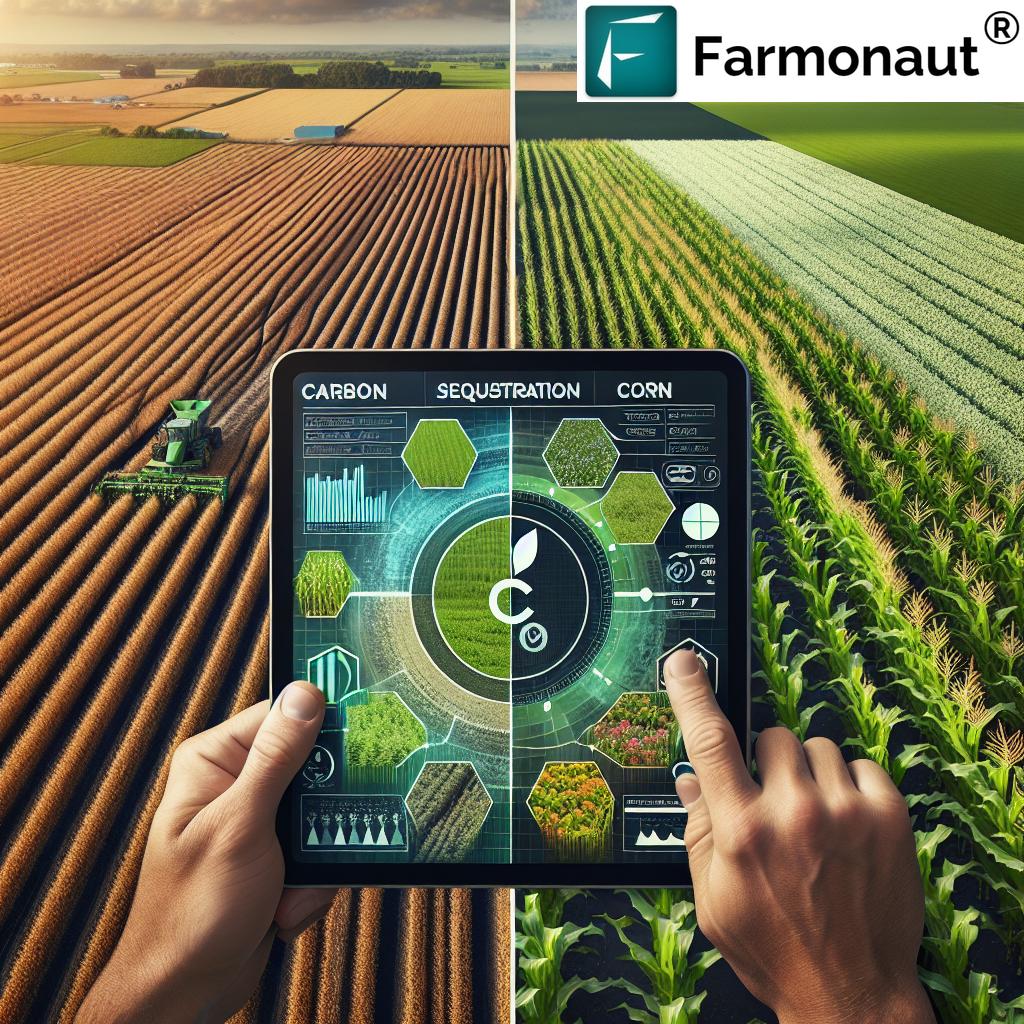
“Carbon credit prices can range from $10 to $50 per ton of CO2 equivalent, varying by market and program.”
Welcome, Illinois farmers! In today’s rapidly evolving agricultural landscape, we find ourselves at the forefront of a new frontier: carbon markets. As stewards of the land, we have a unique opportunity to not only boost our profits but also contribute significantly to global sustainability efforts. This comprehensive guide will navigate you through the complex world of agricultural carbon markets, greenhouse gas reduction strategies, and the innovative tools available to help you succeed.
At Farmonaut, we’re committed to empowering farmers with cutting-edge technology and data-driven insights. Our satellite-based farm management solutions complement carbon market participation by providing precise, real-time data on crop health and soil conditions. As we explore the intricacies of carbon credits, sustainable practices, and market trends, keep in mind how these advanced tools can enhance your farm’s efficiency and environmental impact.
Understanding Carbon Markets for Agriculture
Carbon markets represent a promising avenue for farmers to monetize sustainable practices while contributing to global climate change mitigation efforts. These markets operate on the principle of rewarding practices that either reduce greenhouse gas emissions or sequester carbon in the soil. For Illinois farmers, this presents an opportunity to adopt or enhance conservation practices that can lead to additional revenue streams.
Key Components of Agricultural Carbon Markets
- Carbon Credits: These are tradable certificates representing the reduction or removal of one metric ton of carbon dioxide equivalent (CO2e) from the atmosphere.
- Inset Markets: These involve companies reducing emissions within their own supply chains, often by partnering directly with farmers who supply their raw materials.
- Offset Markets: Here, companies purchase credits from projects outside their direct operations to compensate for their emissions.
- Carbon Intensity Scoring: This metric measures the total greenhouse gas emissions associated with the production and distribution of a product.
For Illinois farmers, understanding these components is crucial as they form the foundation of how carbon markets operate and how agricultural practices can be valued within these systems.
Sustainable Agriculture Practices for Carbon Sequestration
Adopting sustainable agriculture practices is at the heart of participating in carbon markets. These practices not only contribute to carbon sequestration and emissions reduction but also often lead to improved soil health, water retention, and overall farm productivity.
Key Practices for Illinois Farmers
- Cover Cropping: Planting cover crops between growing seasons can significantly increase carbon sequestration, improve soil structure, and reduce erosion.
- Reduced Tillage: Minimizing soil disturbance helps maintain soil carbon stocks and improves soil health over time.
- Precision Nitrogen Management: Optimizing nitrogen application reduces nitrous oxide emissions, a potent greenhouse gas.
- Crop Rotation: Diversifying crop rotations can enhance soil health and reduce the need for synthetic inputs.
“Cover cropping and reduced tillage can sequester up to 0.5-1.5 tons of carbon per acre annually in agricultural soils.”
Implementing these practices not only positions farmers well for carbon market participation but also aligns with the growing consumer demand for sustainably produced agricultural products.
Driving Forces Behind Carbon Markets
The momentum behind agricultural carbon markets is driven by a combination of factors, including:
- Corporate Sustainability Goals: Many companies are setting ambitious targets to reduce their carbon footprint, creating demand for carbon credits.
- Consumer Awareness: Increasing consumer concern about climate change is pushing brands to adopt more sustainable practices throughout their supply chains.
- Government Initiatives: Both federal and state-level policies are encouraging the development of carbon markets and sustainable agriculture practices.
- Technological Advancements: Innovations in remote sensing, data analytics, and blockchain are making it easier to measure, verify, and trade carbon credits.
For Illinois farmers, these driving forces translate into growing opportunities to participate in carbon markets and potentially increase farm revenue.
Current Regulations and Future Legislation
The regulatory landscape for carbon markets is evolving rapidly. While there isn’t a comprehensive federal framework specifically for agricultural carbon markets yet, several initiatives and proposed legislations are shaping the future:
- Growing Climate Solutions Act: This bipartisan bill aims to create a certification program for technical assistance providers and third-party verifiers for carbon credit markets.
- USDA’s Climate-Smart Agriculture and Forestry Strategy: This initiative seeks to incentivize climate-smart agriculture practices and facilitate carbon market participation for farmers.
- State-Level Programs: Illinois, along with other states, is exploring policies to support farmers in adopting sustainable practices and participating in carbon markets.
Staying informed about these regulatory developments is crucial for Illinois farmers looking to engage in carbon markets effectively.
Explore Farmonaut’s API for advanced data integration
Carbon Credit Pricing and Contract Implications
Understanding the pricing dynamics and contract terms in carbon markets is essential for farmers considering participation. Here’s what Illinois farmers need to know:
- Price Variability: Carbon credit prices can vary widely, typically ranging from $10 to $50 per ton of CO2e, depending on the market and program.
- Contract Lengths: Most carbon contracts run for 5-10 years, requiring a long-term commitment to specified practices.
- Payment Structures: Some programs offer upfront payments, while others pay annually or upon verification of carbon sequestration.
- Additionality Requirements: Credits are typically awarded for new or enhanced practices beyond what’s considered standard for the region.
Carefully reviewing contract terms and considering the long-term implications for farm operations is crucial before entering into any carbon credit agreement.
Acreage Requirements and Program Participation
Participation in carbon markets often comes with minimum acreage requirements, which can vary significantly between programs. Here’s what Illinois farmers should consider:
- Minimum Acreage: Requirements can range from as low as 100 acres to 1,000 acres or more, depending on the program.
- Aggregation Options: Some programs allow smaller farms to participate by aggregating their acreage with other farmers.
- Practice-Specific Requirements: Certain programs may have different acreage minimums for specific practices (e.g., cover cropping vs. reduced tillage).
- Field History: Many programs require detailed field histories to establish baselines for carbon sequestration.
Illinois farmers should evaluate their eligible acreage and consider which programs best align with their farm size and management practices.
Check out our API Developer Docs for technical insights
Farmonaut’s Role in Precision Conservation Management
At Farmonaut, we’re committed to supporting farmers in their sustainability efforts through advanced technology. Our satellite-based farm management solutions offer several benefits for farmers participating in carbon markets:
- Real-time Crop Health Monitoring: Our multispectral satellite imagery provides insights into vegetation health (NDVI) and soil moisture levels, helping optimize practices that contribute to carbon sequestration.
- AI-Driven Advisory: Our Jeevn AI system offers personalized recommendations for sustainable farm management, aligning with carbon market requirements.
- Data Collection and Reporting: Farmonaut’s platform can assist in gathering and organizing the data needed for carbon credit verification processes.
- Resource Optimization: By providing precise insights into field conditions, we help farmers reduce unnecessary inputs, further lowering their carbon footprint.
Leveraging these tools can enhance your farm’s efficiency and maximize the benefits of participating in carbon markets.
Navigating Opportunities and Requirements
For Illinois farmers looking to enter the carbon market, here are key steps to consider:
- Assess Your Current Practices: Evaluate which sustainable practices you’re already implementing and identify areas for improvement.
- Research Available Programs: Explore different carbon market programs and their specific requirements for Illinois farmers.
- Understand Measurement and Verification: Familiarize yourself with the methods used to measure and verify carbon sequestration on your farm.
- Consider Long-term Impacts: Evaluate how participating in a carbon program might affect your farm operations over the long term.
- Seek Expert Advice: Consult with agricultural advisors or extension services familiar with carbon markets in Illinois.
Remember, participating in carbon markets is a significant decision that requires careful consideration of your farm’s unique circumstances and goals.
Comparison of Carbon Market Participation Options for Illinois Farmers
| Program Name | Type (Inset/Offset) | Minimum Acreage Requirement | Estimated Credit Price Range ($/ton CO2e) | Key Practices Rewarded |
|---|---|---|---|---|
| Illinois Soil and Water Conservation Districts Carbon Credit Program | Offset | 100 acres | $15 – $25 | Cover cropping, No-till, Reduced tillage |
| Midwest Carbon Exchange | Inset | 500 acres | $20 – $35 | Precision nitrogen management, Cover cropping |
| Heartland Sustainable Agriculture Alliance | Offset | 250 acres | $18 – $30 | Crop rotation, Reduced tillage, Agroforestry |
| Prairie State Carbon Cooperative | Inset/Offset | 1000 acres (Aggregation available) | $25 – $40 | Conservation tillage, Cover cropping, Precision agriculture |
| Illinois Regenerative Agriculture Initiative | Offset | 200 acres | $22 – $38 | Soil health practices, Integrated pest management |
Leveraging Technology for Carbon Market Success
In the evolving landscape of carbon markets, technology plays a crucial role in helping farmers optimize their participation and maximize benefits. Farmonaut’s advanced satellite-based solutions offer several advantages:
- Precision Monitoring: Our satellite imagery provides detailed insights into field conditions, helping you fine-tune practices for optimal carbon sequestration.
- Data-Driven Decision Making: Utilize our AI-powered analytics to make informed choices about crop management and conservation practices.
- Simplified Reporting: Our platform can assist in collecting and organizing the data needed for carbon credit verification, streamlining the reporting process.
- Integration Capabilities: Farmonaut’s API allows for seamless integration with other farm management tools, creating a comprehensive system for both productivity and sustainability.
By leveraging these technological tools, Illinois farmers can enhance their participation in carbon markets while improving overall farm efficiency and sustainability.
Future Outlook and Emerging Trends
As we look to the future of carbon markets and sustainable agriculture in Illinois, several trends are emerging:
- Increased Market Maturity: Expect more standardized practices and pricing as the carbon market matures.
- Technological Integration: Advanced technologies like blockchain and IoT sensors may play a larger role in verifying and tracking carbon credits.
- Policy Evolution: Keep an eye on developing state and federal policies that may further incentivize participation in carbon markets.
- Expanded Practice Recognition: Future programs may recognize a wider range of sustainable practices for carbon credit generation.
Staying informed about these trends will help Illinois farmers position themselves for long-term success in carbon markets.
Conclusion: Embracing Sustainability for Profit and Planet
Navigating the world of carbon markets presents both challenges and opportunities for Illinois farmers. By adopting sustainable practices, leveraging advanced technologies like Farmonaut’s satellite-based solutions, and staying informed about market trends and regulations, farmers can not only boost their profits but also play a crucial role in mitigating climate change.
Remember, participating in carbon markets is a journey that requires careful planning, ongoing learning, and a commitment to sustainable agriculture. As you explore these opportunities, consider how tools like Farmonaut can support your efforts in precision conservation management and data-driven decision-making.
Together, we can build a more sustainable and profitable future for Illinois agriculture, contributing to both local prosperity and global environmental health.
FAQs
- Q: How long does it typically take to see financial returns from participating in carbon markets?
A: Financial returns can vary, but most farmers start seeing returns within 1-3 years of implementing new practices. The timeline depends on factors like the specific program, practices implemented, and market conditions. - Q: Can I participate in multiple carbon programs simultaneously?
A: While it’s possible, it’s important to carefully review each program’s terms. Some programs may have exclusivity clauses or restrictions on stacking credits from the same practices. - Q: How does Farmonaut’s technology assist in carbon market participation?
A: Farmonaut’s satellite-based monitoring and AI-driven analytics help track field conditions, optimize sustainable practices, and gather data needed for carbon credit verification, streamlining the participation process. - Q: Are there any risks associated with long-term carbon market contracts?
A: Potential risks include changes in farm operations that may conflict with contract terms, market price fluctuations, and evolving regulations. It’s crucial to thoroughly understand contract obligations before committing. - Q: How can small-scale farmers in Illinois participate in carbon markets?
A: Small-scale farmers can explore aggregation options, where multiple farms combine their acreage to meet minimum requirements. Some programs also offer specific options for smaller operations.






